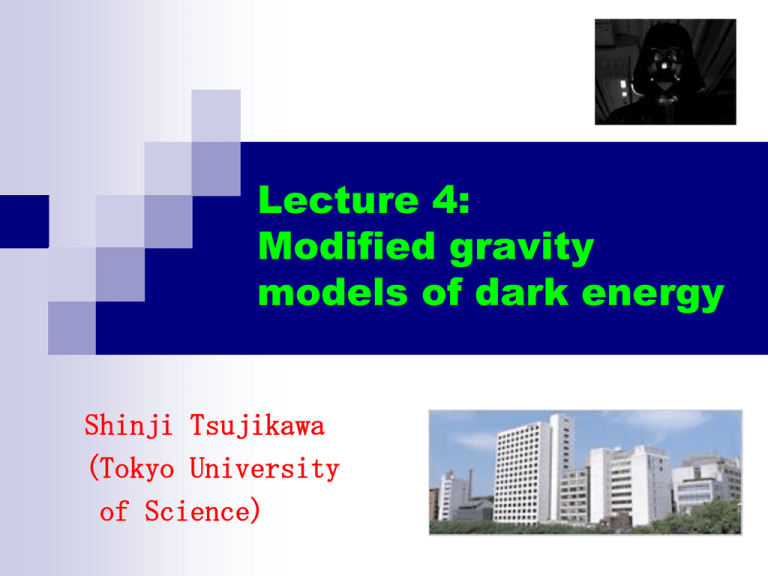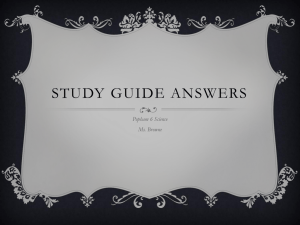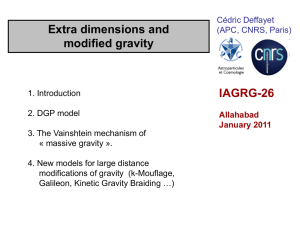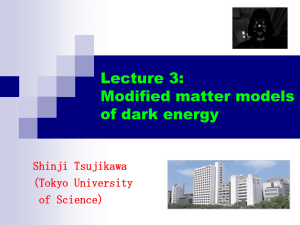Lecture IV
advertisement

Lecture 4: Modified gravity models of dark energy Shinji Tsujikawa (Tokyo University of Science) Modified gravity models of dark energy This corresponds to large distance modification of gravity. (i) Cosmological scales (large scales) Modification from General Relativity (GR) can be allowed. (ii) Solar system scales (small scales) The models need to be close to GR from solar system experiments. Beyond GR ??? GR+small corrections Concrete modified gravity models or f (R) gravity GR Lagrangian: (R is a Ricci scalar) Extensions to arbitrary function f (R) f(R) gravity The first inflation model (Starobinsky 1980) Starobinsky 2 Inflation is realized by the R term. Favored from CMB observations Spectral index: Tensor to scalar ratio: N: e-foldings f(R) dark energy models (more than 500 papers) Capozziello Turner Capozziello, Carloni and Troisi (2003) Carroll, Duvvuri, Trodden and Turner (2003) Please see the review article: A. De Felice and S. Tsujikawa, Living Reviews in Relativity, 13, 3 (2010) Conditions for the cosmological viability of f(R) models 1. 2. To avoid ghosts To avoid tachyonic instability The mass M of a scalar-field degree of freedom needs to be positive for consistency with local gravity constraints (LGC). This condition is also required for the stability of perturbations. 3. (R0 : present cosmological Ricci scalar) For the presence of the matter era and for consistency with LGC. 4. The presence of a stable late-time de Sitter point Viable f(R) dark energy models 1. Hu and Sawicki, 2007 2. Starobinsky, 2007 3. S.T., 2007 Cosmological constant disappears in flat space-time. The models approach the LCDM for . (for the models 1 and 2) The local gravity constraints can be satisfied for (Capozziello and S.T., 2008) Cosmology of viable f(R) models (i) During radiation and deep matter eras ( the models are close to the LCDM model: ), ‘GR regime’ (ii) Around the end of the matter era to the accelerated epoch, the deviation from the LCDM model becomes important. ‘Scalar-tensor regime’ The existence of this regime leaves several interesting observational signatures: • Phantom equation of state of DE • Modified matter power spectrum • Modified weak lensing spectrum Dark energy equation of state in f(R) models Friedmann equations in the FLRW background where 8 G f 2 F 3H ( DE m ) 2 2 ( rad 0 ) 2 2 HÝ ( DE p DE m ) R where 2 2 DE (1 / 2)( FR f ) 3HFÝ 3H (1 F ) 2 Ý 2 H FÝ (1 / 2)( FR f ) (2 HÝ 3H 2 )(1 F ) p DE FÝ This satisfies w DE p DE DE ÝDE 3H ( DE p DE ) 0 w eff 1 F m 2 w eff 1 (2 HÝ/ 3H ) m m / 3FH 2 Phantom equation of state in f(R) models Phantom equation of state can be realized without the appearance of ghosts and instabilities. (Starobinsky’s model) g This property is useful to discriminate f(R) models from future SN Ia observations. Matter perturbations in viable f(R) models Large-scale structure where (S.T., 2007) is the deviation parameter from the LCDM. ( (i) k 2 m 1 2 a R (ii) k 2 Standard evolution: t 2 / 3 m (early time: ‘GR regime’) Non-standard evolution: m t (late time: ‘Scalar tensor regime’) This enhances the growth rate of matter perturbations. ( 2 a R ) m 1 33 1) / 6 The transition point from the ‘GR regime’ to the ‘scalar tensor regime’ is characterized by k 2 2 m 1 a R For the k modes relevant to matter power spectrum, this occurs during the matter era at t k k 3 /( 6 n 4 ) For the Starobinsky’ model: This leads to the difference of spectral indices between the matter power spectrum and the CMB spectrum: n s 33 5 6n 4 Starobinsky (2007) Numerically confirmed by S.T. (2007) Matter power spectra Small-scale spectra are modified. Starobinsky’s f(R) model with n=2 LCDM [h/Mpc] It will be of interest to see whether the signature of f(R) gravity can seen in future observations. Conformal transformation in f (R) gravity where where where we used _________________ Chameleon mechanism where Massive (local region) Massless (Cosmological region) . . In the local region with high density, the field does not propagate freely because of a large effective mass. where Because of the presence of a matter coupling with the field, the field is nearly frozen with a large mass. High-density (massive) Low-density . The field is nearly frozen. The detailed calculation shows that the solar-system constraints are satisfied for Braneworld models of dark energy 5-th dimension Dvali, Gabadadze, Porrati (DGP) model 3-brane is embedded in the 5-dimensional bulk Bulk 3-brane On the 3-brane the Friedmann equation is (for the flat case) where There is a de Sitter attractor with (self acceleration) • DGP model is disfavored from observations. Even in the presence of cosmic curvature K, the DGP model is in high tension with observations. SN Ia BAO • Moreover the DGP model contains a ghost mode. Theoretical curve The DGP model is disfavored from both theoretical and observational point of view. Galileon gravity Galileon cosmology : five covariant Galileon Lagrangians (second-order) Cosmological evolution in Galileon cosmology De Felice and S.T., PRL (2010) Tracker solution Gauss-Bonnet gravity A. De Felice, D. Mota, S.T. (2009) where Considering the perturbations of a perfect fluid with an equation of state w, the speed of propagation is Excluded! Summary of modified gravity models of dark energy Papers including ‘dark energy’ in title: 2620 Papers including, ‘cosmological constant’ in title:1853 Exponential growth Steady state 謝謝 If you have further questions, please contact to











